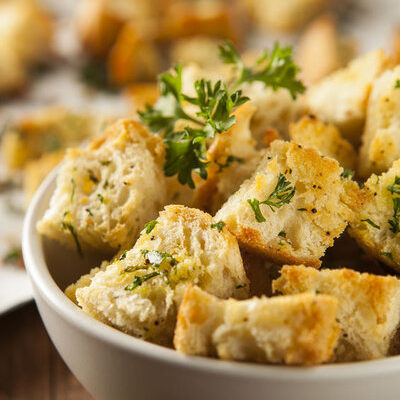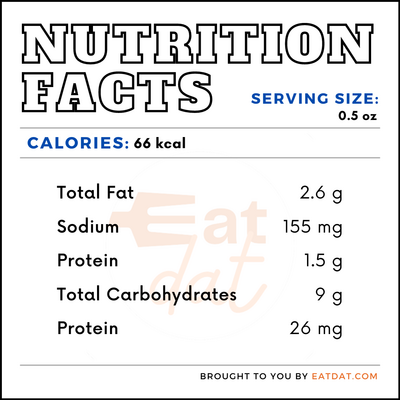
Croutons
What are Croutons?
Croutons are small, cubed, seasoned pieces of bread that can be sauteed, baked or fried. This bread product is known for its crunchy texture and is commonly eaten in salads and soups. Croutons are usually seasoned with herbs and oil or butter.
- One of the most popular flavorings used for these crunchy bites is garlic.
- This bread product is also featured in the Caesar salad, which is the second most popular salad in the United States.
The top 7 most popular crouton brands in the US are:
- Fresh Gourmet
- New York
- Rothbury Farms
- Olivia’s
- Osem
- Member’s Mark
- Olive Garden
Origin of croutons
This bread came about as a way for people to utilize stale bread. Some point to Medieval times as a likely period for the creation of this food, as eating soup with stale bread was quite common. Furthermore, French onion soup traditionally uses a crust of stale bread, and the word ‘crouton’ originates from French. However, others argue that this bread product may have originated from the Italian biscotti, a twice-baked bread. What is certain is that the word crouton has been used in English since the 19th century and these crunchy bites remain very popular to this day.
Function
While croutons are most commonly used to add texture and flavor to salads, they can be used in many other dishes. These crunchy bites can be added to scrambled eggs or omelets, creamy soups, chunky stews, and roasted fish or meats. Not to mention that croutons can also help substitute stuffing in a pinch, whether that’s in stuffed vegetables or stuffed turkey on Thanksgiving Day.
Nutrition
A 0.5 ounce serving of this food provides:

Croutons are low in fat, sugar, and cholesterol, but don’t offer many vitamins or xminerals. These crunchy bites also contain trace amounts of iron, calcium, and vitamins A and C. However, for a more balanced diet, this bread product should be consumed with other foods.
Commercial Production
The commercial production of this bakery product begins with blending a variety of flours, water, and other ingredients. Then, these ingredients are mixed until a dough forms and that dough is placed in a dough dividing machine. This machine separates the dough into small balls that are sent to the intermediate proofer for 5-20 mins. Next, the balls of dough are moved to the molder, which forms them into loaves before they are placed into loaf pans.
The loaves are left to proof to double it’s size and then baked in the oven till their internal temperature reaches 200oF (93.3oC). Once the loaves are baked, they are removed from the oven, allowed to cool, and then air dried overnight. This overnight drying encourages the staling of the bread, which is needed to make it firmer for cutting. If the bread does not stale enough, the cutting machines will gum up. The following day, the loaves are cut using a cutting machine that cubes the bread, creating the iconic crouton shape. Then, the cubed bread is seasoned with a signature seasoning blend and spread onto baking trays. Finally, the croutons are baked at a lower temperature to dry it out, left to cool, packaged, and stored until they’re ready to be sold.
Uses
Savory and crunchy croutons can add texture and flavor to anything from cold salads to hot baked dishes. Although if you want to enjoy this food to the fullest, you should take care to store it properly. If this bread product is store-bought, be sure to keep it in the packaging it comes in and follow the ‘best by’ date. The best way to store homemade croutons is in a ziplock bag at room temperature for up to two weeks. It’s also possible to freeze these crunchy bites if you want to keep them for up to one month.
Crouton recipes
This bread can breathe life into a variety of dishes. Here are some popular recipes:
- Homemade Croutons
- Classic Caesar Salad
- Tossed Salad with Homemade Croutons
- Spinach and Chicken Bake with Croutons
- Scrambled Eggs with Herbed Croutons
FDA Regulation
The Food & Drug Administrations classifies all types of bread and relates products as bakery products. The FDA groups croutons and bread crumbs in the same category. In 2010, the FDA set sodium reduction goals for this food. The FDA also offers their recommended reference amount for croutons.
References
“Bread Croutons Trends, Analytics And Statistics.” Tastewise, Tastewise, www.tastewise.io/foodtrends/bread croutons.
Olver, Lynne. “Croutons.” The Food Timeline, The Food Timeline, www.foodtimeline.org/foodbreads.html.
“FDA Food Categories and Voluntary Targets.” Fda.gov, U.S. Food & Drug Administration, www.fda.gov/media/98552/download.
